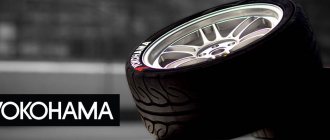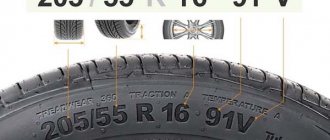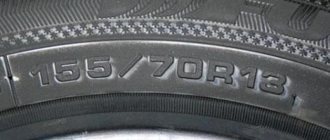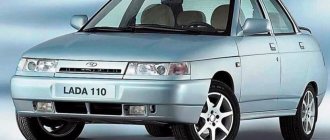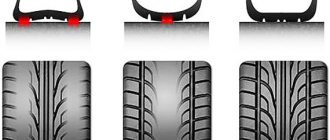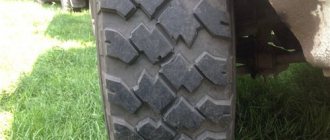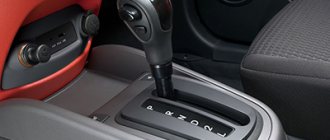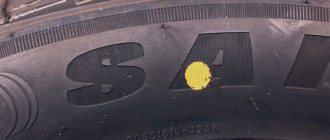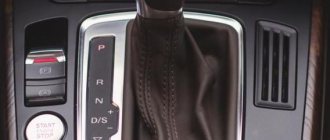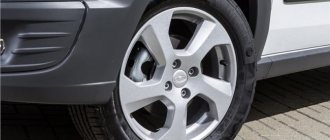When choosing a tire, special attention should be paid to the tire markings. The symbols encrypted in them will help you choose a set of tires with suitable characteristics. One of the most important parameters that plays a big role is the load and speed indicator. Decoding this index for tires will serve an excellent purpose when purchasing tires for a car.
All tire manufacturers are required to include detailed product information on their products. Mandatory markings include the tire size designation. This characteristic plays a big role and indicates whether ramps can be used on a particular car or not.
All manufacturers have three types of designations - European or two American. Tires produced for European countries are marked as 195*55*R17. The width of such a tire will be indicated by the first number, and the profile height or internal diameter will be indicated by the remaining two indicators. This means we have a tire with a tread width of 19.5 cm, a profile of 55% and it is suitable for a 17-inch wheel.
The American classification resembles the European one, however, additional indicators are indicated before the size that indicate the orientation of the tire. For example, LT 185*45*R17 tires are aimed at a small truck (Light Track), and a P205*45*R18 tire is suitable for a passenger car (Passenger).
Sometimes on car tires you can find inch designations, such as 30*10.5*R17, the first number of which will indicate the outer diameter of the tire, the second will indicate the tread width, and the third will indicate the internal diameter. This marking is even more convenient, because in the European version you need to have a calculator on hand to calculate the profile height, which depends on the width, but here all the values are static.
The letter R is an index indicating that the wheel has a radial section cord. Almost all rubber for passenger cars has this structure. Diagonal weaving is indicated by the symbol “/”. Such tires are cheaper, but weigh more, carry less load and wear out faster. Radial products are preferable in every sense.
Tire size
Dimension is a mystery for many. It seems that there are no problems in everyday life: what numbers are indicated on the sidewall of a standard tire, with these you need to buy a winter or summer one to replace the worn one. But what exactly do they mean? For example, let's take the index 225/50 R17 98 N on a Continental tire.
Continental PremiumContact 6
Continental PremiumContact 6
- 225
— tread width in millimeters.
Where is it indicated?
Typically, the tire load index is indicated as a two or three-digit number on the sidewall immediately after the tire size.
ATTENTION: for safety reasons, this indicator must necessarily correspond to the minimum value recommended by the manufacturer of your car, despite the fact that the tire load index can be calculated independently (how to do this is written below).
Additional designations
Additional letters may be added to the tire model name. For example, SUV means focus on crossovers and SUVs (reinforced sidewall, high load capacity), C - on commercial vehicles (from the English cargo, “cargo”). It happens that a tire is welded specifically for a particular automaker and is intended for initial assembly on an assembly line or for sale through its official dealers. Thus, the Continental company reserves the indices A0 and R01 for Audi, J for Jaguar, N0, N1, N2 for Porsche, M0, M01 for Mercedes.
Date of manufacture
One of the key parameters is the tire release date. You need to look at it when buying a new set, not to mention a used one. It is not recommended to drive on tires for more than five to six years from the date of issue, although it is not prohibited either by law or by the manufacturers themselves. The date of manufacture is indicated by four digits in an oval. The first two are a week, the second two are a year. For example, 3119 represents the "cooking" of the 31st week of 2022.
Wear indicators
The locations of critical tread wear marks on Continental tires are indicated by the letters TWI. On summer models they are supplemented with indicators with cross and drop marks. They signal that the tires have not yet reached the minimum tread height, but it is no longer enough to feel confident in the rain.
There are also VAI indicators on the tread. They are applied symmetrically in the left and right shoulder areas. If the wheels are installed correctly, they change exactly the same as the tires wear out. Discrepancies are a reason to visit the wheel alignment stand. So far, the technology is used only on truck tires.
Which class of tires is best suited for SUVs and crossovers according to car owners?
- “The AT marking is the best option for long fishing trips out of town and the like. Of course, without extreme sports, such as long distances on dirt and asphalt surfaces. These tires have excellent wear resistance.”
- “Simple calculation: even if you go for rides EVERY week. One run or trip to nature is on average 100 km. 100 km * 52 weeks = 5200 km. With a standard average mileage of 30 thousand per year, this is quite a bit, about 1/6 of the total mileage. An SUV is still bought for daily use, and not for outdoor life, so the tires must be selected accordingly. I have tires marked NT - I think this is the best option, especially since I never get into particularly muddy conditions.”
- “I had tires marked AT on two SUVs: UAZ Patriot and Ford Explorer. My opinion is that these tires have excellent wear resistance. They have no more advantages. If you move on not too extreme off-road conditions, the wheels are more or less lifted due to a fairly aggressive pattern. While I was driving like this, everything was fine. But when you switch to something else, you realize that everything was wrong. AT has several serious disadvantages: the rubber does not hold wet asphalt and compacted snow well, and does not hold ice at all. If on cars similar in suspension to cars (like my Ford), this is still relatively normal, then on cars close to trucks (Patriot), all the disadvantages immediately come to the surface.”
New marking
In Russia, mandatory tire labeling is being introduced in order to combat “gray” supplies. The unique Data Matrix code is highly secure and can be read through several layers of packaging. It is declared that it cannot be falsified or copied, and the information embedded in it can be read even if partially damaged. The code can be deciphered by every buyer. To do this, you need to scan it with a special mobile application “Honest Sign”. After which, information about the manufacturer and importer, product characteristics, and the date of introduction into circulation in Russia will be displayed on the gadget’s screen.
Mandatory labeling will be introduced from November 1, 2022. From this day forward, the production, import into Russia, and purchase from manufacturers and importers of rubber without standard markings is prohibited. From December 15, all circulation of unmarked tires will be prohibited. Warehouse balances are allowed to be tagged until March 1, 2022.
Mandatory labeling will be introduced from November 1, 2022. From this day forward, the production, import into Russia, and purchase from manufacturers and importers of rubber without standard markings is prohibited. From December 15, all circulation of unmarked tires will be prohibited. Warehouse balances are allowed to be tagged until March 1, 2022.
The Continental concern was at the forefront of testing the technology in Russia and is fully ready for its implementation. During 2019, he, along with hundreds of other companies from different industries in our country, generated thousands of codes while refining the system. Moreover, on a global scale, the company has already prepared solutions for integrating electronic chips into tires, allowing them to monitor their condition, including the degree of wear.
Correct selection of coefficient
When buying tires, you should take a responsible approach to the issue of choice.
The starting point should be the maximum speed of the machine. The tire category must be no less than this indicator. Of course, you can purchase a cheap kit with a reduced speed category, but such a decision must be compensated by extremely careful driving. After all, even if the speed limit is exceeded by 10 km/h, the tread quickly wears out, and the wheel can completely collapse while driving, which will lead to an accident and costly repairs. If your vehicle accelerates to 250 km/h, like most modern cars, you should give preference to tires with the letter U in the markings.
When choosing a set of winter wheels, the tire speed index is no longer so important for the car. The car simply cannot reach high speeds due to operating conditions. Therefore, here you should focus not on the speed of the car, but on other parameters of the operation of the car. For example, if the permissible speed index for summer wheels is 91v, then in the case of a winter set you can purchase tires with an index of 91h.
Additionally, you should pay attention to a number of features in the labeling.
- Letters RF (RunFlat). Many models have a rigid cord that allows them to cover a distance of 80 kilometers when punctured and the pressure drops to zero. In this case, the tire will remain “combat ready” after repair;
- The DOT or E designation symbolizes compliance with American or European standards;
- Colored marks on the sidewall indicate the hardest, softest or lightest areas (depending on color). This provides information for tire workers or makes it easier to install it on the rim yourself;
- The letter R symbolizes that it belongs to the class of radial tires. Almost all wheels for passenger cars have a radial weave, which is superior in every way to a diagonal weave (indicated by the “\” sign). You can learn more about the self-installation procedure from the profile video;
- Often, an arrow is drawn on the sidewalls, indicating the direction of rotation of the wheel, or the inscription Outside, which allows you to correctly mount tires with an asymmetric pattern;
- TWI are special indicators located in random places and are an indicator of tire wear. The last mark is applied at a tread height of 1.6 mm, corresponding to the last critical value. Helps determine the degree of tread wear without special tools.
Load Index
| Load Index | Tire load, kg | Load Index | Tire load, kg | Load Index | Tire load, kg |
| 76 | 400 | 86 | 530 | 96 | 710 |
| 77 | 412 | 87 | 545 | 97 | 730 |
| 78 | 425 | 88 | 560 | 98 | 750 |
| 79 | 437 | 89 | 580 | 99 | 775 |
| 80 | 450 | 90 | 600 | 100 | 800 |
| 81 | 462 | 91 | 615 | 101 | 825 |
| 82 | 475 | 92 | 630 | 102 | 850 |
| 83 | 487 | 93 | 650 | 103 | 875 |
| 84 | 500 | 94 | 670 | 104 | 900 |
| 85 | 515 | 95 | 690 |
How to calculate it yourself
If necessary, you can calculate the vehicle load index yourself.
To do this, take the following steps:
- Add up the curb weight and the vehicle's carrying capacity.
- Divide the resulting parameter by four.
- Get the number of kilograms that are allowed on one wheel.
- Add 35-40 percent of the resulting number on top.
- Look in the table to see which load index the found number corresponds to.
When calculating, you need to know the following information:
- Curb weight is the weight of the car with technological components, such as oil, gasoline / diesel fuel, and the driver.
- Load capacity is the maximum weight that a vehicle can carry, taking into account information from the manufacturer.
- Gross weight - the total weight of the equipped and loaded vehicle with weight, repair kit, people, etc.
For example, if a vehicle has a curb weight of 1500 kg and a payload capacity of 1000 kg, the gross weight is 2500 kg. Divide this number by four and get 625 kg. Add 40% to this number and get 875 kg. We look at the table and see that this parameter is at level 103.
Why do you need to add 35-40?
Some increase the resulting calculations by 15%, but this does not change the overall meaning.
When driving, the car is subject to downforce from the oncoming air flow, which is difficult to calculate accurately due to the aerodynamics of the car under different operating conditions.
The higher the speed, the more downforce acts on the car, and therefore on the tires.
It is also important to understand that the weight of the car is not distributed evenly between the front and rear axles; as a rule, the load ratio varies 40 to 60, 35 to 65, etc.
Also, when driving on bad roads, the load on the tires increases when hitting obstacles, falling into holes, etc.
Don’t forget about long descents, where the load on the tires also increases, especially on the front ones.
Speed index
| Speed index | Q | R | S | T | H | V | W | Y | VR | ZR | ZR(Y) |
| Speed, km/h | 160 | 170 | 180 | 190 | 210 | 240 | 270 | 300 | >210 | >240 | >300 |
- What does a tire say about car problems? find out here.
Photo: Continental
Icons and letters on tires: deciphering all the symbols!
